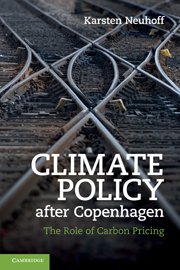Climate Policy after Copenhagen - The Role of Carbon Pricing
Karsten NEUHOFF
Availability: Out of stock - available in 10 open days
- Categories: Environnement
- Publisher: CAMBRIDGE UNIVERSITY PRESS
- ISBN: 9781107401419
- Publication Date: 15/06/2011
- Binding: Paperback
- Number of pages: 296
Summary
At the UN Climate Negotiations in Copenhagen, 117 heads of state concluded that low-carbon development is necessary in order to combat climate change. However, they also understood that transition to a low-carbon economy requires the implementation of a portfolio of policies and programs – a challenging endeavour for any nation. This book addresses the need for information about factors impacting climate policy implementation, using as a case study one effort that is at the heart of attempts to create a low-carbon future: the European Emission Trading Scheme. It explores problems surrounding the implementation of the ETS, including the role of vested interests, the impact of design details and opportunities to attract long-term investments. It also shows how international climate cooperation can be designed to support the domestic implementation of low-carbon policies. This timely analysis of carbon pricing contains important lessons for all those concerned with the development of post-Copenhagen climate policy.
• Explains the economics of carbon pricing without using equations so that the book is more accessible to a broader set of actors
• Uses the example of the EU Emissions Trading Scheme to explore the politics, design and implementation of climate policy instruments
• Explores financial mechanisms to encourage/facilitate south-north cooperation and the links between domestic policy implementation and international cooperation
Table of contents
List of figures;
List of tables;
List of text boxes;
1. Introduction;
2. The role of a climate policy mix;
3. Implementing a carbon price, the example of cap and trade;
4. Shifting investment to low-carbon choices;
5. Co-operation among developed countries – a role for carbon markets?;
6. A world of different carbon prices;
7. International support for low-carbon growth in developing countries;
8. Conclusion;
References;
Index.
